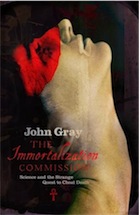“The Immortalization Commission: Science and the Strange Quest to Cheat Death” by John Gray

You know how some magazines sit around for a LONG time, since you want to read them, but you know that it would probably take as much time as a book, and who has time for that? A friend had lent me a copy of Harper’s magazine from early 2011, and I didn’t even remember which article or story was the reason, but I finally got around to reading it, and whether it was the intended article at the time, what I was most interested in was Zadie Smith’s review of John Gray’s book The Immortalization Commission: Science and the Strange Quest to Cheat Death. Alas, the link is only available to subscribers at Harpers.org.
Gray’s book is short but not a quick read. I felt out of practice with my academ-ese, but I muddled through, though I did feel at times rather dim. His topic is the muddy and contentious areas of science and occult in the post-Darwin years. Occultists in England were seeking scientific proof of the afterlife from a growing library of “automatic writings,” material channeled by mediums ostensibly from the dead or yet to be. Scientists in Russia pursued immortality and human perfection through any number of atrocities that pre-figured those of the Nazis during WWII.
There is no pristine science untouched by the vagaries of faith (5)
Speaking of Russia, WTF? Reading this book made my jaw drop. It seemed that all government people in Russia did was run around, plot, kill and poison each other, and then murder millions of citizens, either by mass starvation or guns. That is some scary stuff, people. Much more gruesome than the tidy, repressed Victorians who were trying to talk to ghosts.
Gray’s book was not an easily accessible book for me. It had lots of esoteric vocabulary, that even though I was familiar with, e.g., hermeneutics, the study of texts, which I find is a litmus test of discourse level. If the author uses “hermeneutics” it is high Academ-ese, as a professor of mine once called it. But it’s not fair, and kind of embarrassing to say that it was hard to read because the words were hard, but I’m just sayin’. But other things would have helped a great deal: labelling photos rather than having an illustration list at the front to be flipped back to, end notes that were noted by number, not just clumped at the end. These made the book tidy, so perhaps visually easier to read, but didn’t help illustrate some of his points as he made them. Further, a timeline at the beginning of people’s deaths, as well as clearer delineation within the book of the chronology of events would have helped. In the English Cross-Correspondences section, one man was apparently channeling another, whom it wasn’t clear had died.
Those things aside, this was fascinating stuff, especially in the wake of reading The Karamazov Brothers, since Dostoevsky was writing in this post-Darwinian period of doubt, faith, and possibility.